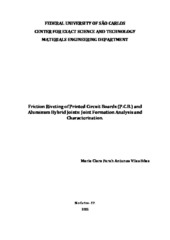| dc.contributor.author | Vilas Bôas, Maria Clara Farah Antunes | |
| dc.date.accessioned | 2022-06-15T14:17:38Z | |
| dc.date.available | 2022-06-15T14:17:38Z | |
| dc.date.issued | 2022-04-14 | |
| dc.identifier.citation | VILAS BÔAS, Maria Clara Farah Antunes. Friction riveting of printed circuit boards (P.C.B.) and aluminum hybrid joints: joint formation analysis and characterization. 2022. Trabalho de Conclusão de Curso (Graduação em Engenharia de Materiais) – Universidade Federal de São Carlos, São Carlos, 2022. Disponível em: https://repositorio.ufscar.br/handle/ufscar/16290. | * |
| dc.identifier.uri | https://repositorio.ufscar.br/handle/ufscar/16290 | |
| dc.description.abstract | This work addressed the feasibility study of the Friction Riveting joining process on glass-fiber-reinforced epoxy resin laminate sheet (FR4-PCB) and 2024-T351 aluminum alloy rivets by investigating the rivet scale effects, the amount of copper layer on the surfaces of the plates, and their influence on heat development, and material behavior as well as subsequent joint formation and properties, including microstructure and mechanical performance of the joints. The research work was carried out at the Institute of Materials Mechanics Solid State Joining Processes Helmholtz-Zentrum Hereon in Germany in collaboration with the Material Engineering Department of the Federal University of São Carlos. The one-factor-at-a-time (OFAT) approach was used to investigate the influence of process parameters on the process temperature, macro and microstructural deformation, and mechanical properties. The macro and microstructural characterization were carried out by light optical microscopy (L.O.M.) and the mechanical
properties of the joints were determined by T-pull tensile testing. The results demonstrated the viability of the process for the case of FR4 material with AA2024; joints with good mechanical performance (828 N ± 65 N) were achieved using FR4 composites plates with reduced thickness (1.5 – 3.0 mm), the thinnest plates successfully joined via Friction Riveting so far. The downscaling was accomplished regarding the size of the rivet and the joints made with a smaller diameter (4mm) rivet demonstrated similar results to the joints with a 5mm diameter rivet. To improve and analyze the main process parameters, the Design of Experiments (D.O.E.) was used. Considering the effect on the temperature generated during the process, the rotational speed shows a high impact, followed by the material combination (one or double copper layer), once the higher rotational speed generates greater friction between the metal and the composite and the high conductivity of the copper contributes to the heating spread. | eng |
| dc.description.sponsorship | Não recebi financiamento | por |
| dc.language.iso | eng | por |
| dc.publisher | Universidade Federal de São Carlos | por |
| dc.rights | Attribution-NonCommercial-NoDerivs 3.0 Brazil | * |
| dc.rights.uri | http://creativecommons.org/licenses/by-nc-nd/3.0/br/ | * |
| dc.subject | Rebitagem por fricção | por |
| dc.subject | Ligas de alumínio | por |
| dc.subject | Friction riveting | eng |
| dc.subject | Aluminum alloys | eng |
| dc.subject | FR4 | eng |
| dc.subject | AA2024 | eng |
| dc.title | Friction riveting of printed circuit boards (P.C.B.) and aluminum hybrid joints: joint formation analysis and characterization | eng |
| dc.title.alternative | Rebitagem por fricção de placas de circuito impresso (P.C.B.) e juntas híbridas de alumínio: análise e caracterização da formação de juntas | por |
| dc.type | TCC | por |
| dc.contributor.advisor1 | Gargarella, Piter | |
| dc.contributor.advisor1Lattes | http://lattes.cnpq.br/4641435644243916 | por |
| dc.contributor.advisor-co1 | Blaga, Lucian | |
| dc.description.resumo | Este trabalho aborda o estudo da viabilidade do processo de união por Friction Riveting em folha laminada de resina epóxi reforçada com fibra de vidro (FR4-PCB) e rebites de liga de alumínio 2024-T351, investigando os efeitos do tamanho do rebite, a quantidade de camada de cobre nas superfícies das placas e sua influência no desenvolvimento de calor e comportamento do material, bem como na formação e propriedades subsequentes da junta, incluindo microestrutura e desempenho mecânico. O trabalho de pesquisa foi realizado no Institute of Materials Mechanics Solid State Joining Processes Helmholtz-Zentrum Hereon, localizado na Alemanha, em colaboração com o Departamento de Engenharia de Materiais da Universidade Federal de São Carlos (DEMA). Para investigar a influência dos parâmetros na temperatura do processo, deformação macro e microestrutural, propriedades mecânicas, mecanismos de fratura e degradação térmica da zona de ancoragem das juntas, mudou-se um parâmetro por vez (método one-factor-at-time). A caracterização macro e microestrutural foi realizada por microscopia óptica (LOM) e as propriedades mecânicas das juntas foram determinadas por ensaios de tração em forma de T-pull. Os resultados demonstraram a viabilidade do processo para o caso do material FR4 com AA2024; juntas com bom desempenho mecânico (828 N ± 65 N) foram alcançadas utilizando placas de compósitos FR4 com espessura reduzida (1,5 – 3,0 mm), as placas mais finas unidas com sucesso via Friction Riveting até o momento. O downscaling foi realizado em relação ao tamanho do rebite e as juntas obtidas com o rebite de menor diâmetro (4mm) apresentaram resultados parecidos com as produzidas com rivet de 5mm de diâmetro. Para melhorar e analisar os principais parâmetros do processo foi utilizado Design de Experimentos (DOE).
Considerando o efeito na geração de temperatura durante o processo, a velocidade rotacional apresentou a maior influência, seguida da combinação de materiais (uma ou dupla camada de cobre), uma vez que a maior velocidade rotacional gera maior atrito entre o metal e o compósito e a alta condutividade do cobre contribui para a propagação do aquecimento. | por |
| dc.publisher.initials | UFSCar | por |
| dc.subject.cnpq | ENGENHARIAS::ENGENHARIA DE MATERIAIS E METALURGICA::METALURGIA FISICA | por |
| dc.publisher.address | Câmpus São Carlos | por |
| dc.publisher.course | Engenharia de Materiais - EMa | por |

